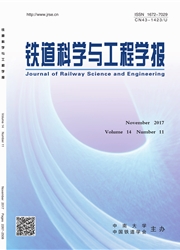

 中文摘要:
中文摘要:
采用实体单元模拟轨道结构、接触单元模拟层间约束关系、仅受压的杆单元模拟桥梁对轨道的支撑和非线性弹簧单元模拟扣压型恻向挡块的约束作用,建立高速铁路简支梁桥上CRTSⅡ型板式无砟轨道结构空间有限元模型,采用相关文献案例验证本模型的准确性,分析温度作用下桥上CRTSⅡ型板式无砟轨道离缝发展规律及变形.研究结果表明:整体升温对轨道板与砂浆层界面纵向剪应力影响较大,温度越高,纵向剪应力越大,但在正常使用范围内,界面不会发生纵向剪切破坏;温度梯度主要引起界面竖向拉裂破坏,进而产生砂浆离缝,离缝从轨道板边缘开始出现,在正负温度梯度交替作用下,沿横向深度加深,深度可达50cm;当界面黏结强度为0.02MPa时,砂浆离缝产生的临界正温度梯度为5.3℃,临界负温度梯度为-4.8℃,且二者呈线性关系,黏结强度越高,临界温度梯度越大.轨道板板端接缝缺陷引起接缝位置及纵向一定范围内界面拉裂破坏,沿横向贯通,导致砂浆离缝和轨道板板端上拱;提高砂浆层.施工质量和加强轨道板板端接缝.施工控制有利于抑制砂浆离缝和轨道板上拱变形.
 英文摘要:
英文摘要:
An entity CRTSⅡ slab ballastless track structure on simply - supported beam bridges of high-speed railway finite element model ( FEM) was established. In this model, the solid finite elements were used to simu-late track structure, the contact elements were applied to simulate the contact relationship between adjacent lay-ers ,the compression bar elements were used to simulate the bridges and the nonlinear spring elements were ap-plied to simulate the pigeonhole type lateral blocks. The results of finite element and related literature case veri-fied each other. Research shows that: Overall heating has large effect on the longitudinal shearing stress between the interface of track slab and mortar. The stress rises as the temperature increases, but interface longitudinal shear failure will not occur within the normal operating range of the structure. Temperature gradient mainly influ-ences the vertical positive stress of the interface, it can lead to vertical tensile failure and then produce mortar open joint. The open joint appears at the edge of track slab, under the alternate effect of increases and decreases of temperature the open joint progresses along the horizontal depth which could reach as deep as 50 cm. When the bonding strength of the interface is 0.02 MPa, the positive and negative critical temperature gradient is 5.3 ℃and -4.8℃ respectively for the appearance of mortar open joint. There is a linear relationship between temperature and strength, the critical temperature gradient becomes larger as the bonding strength grows. The fault in seam at the edge of track slabs causes tensile failure of interface in certain longitudinal range near the seam and transfixes along the transverse direction and finally result in mortar seam and upwarp at the end of track slab. Advancing the construction quality of mortar and enhancing the control of seam construction are beneficial to restrain mortar seam and upwarp deformation.
 同期刊论文项目
同期刊论文项目
 同项目期刊论文
同项目期刊论文
 期刊信息
期刊信息
